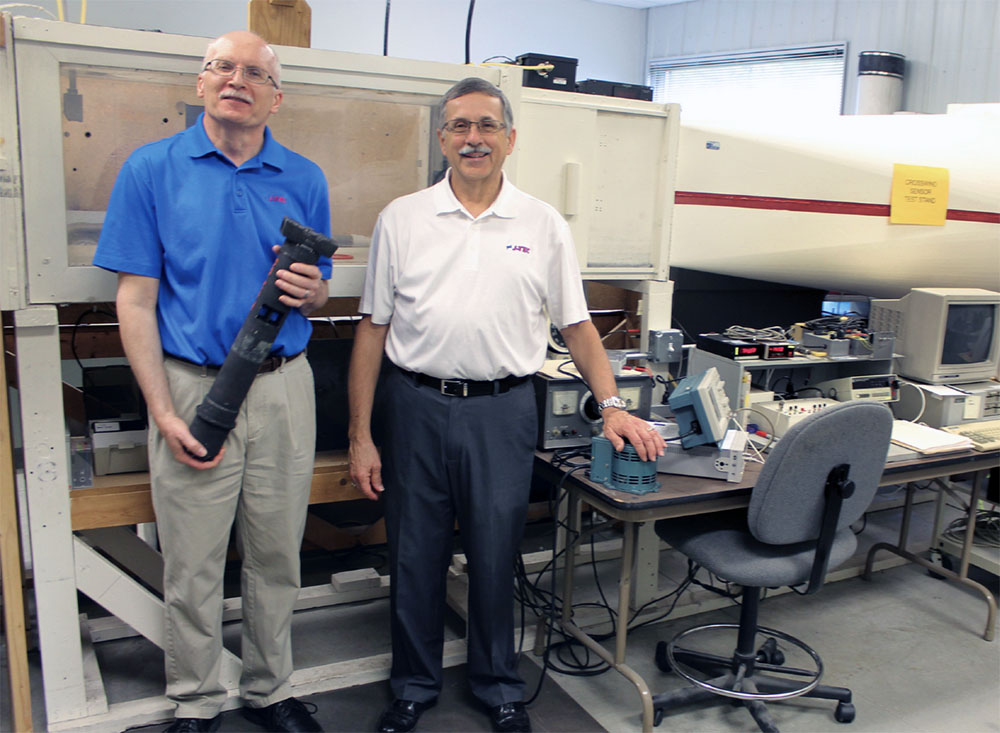
J-TEC Engineer Tom Hamilton (left) displays one of the company’s crosswind sensors while talking to President Gary Roling at the company’s plant in Marion during a 50th anniversary open house. PHOTO DAVE DEWITTE
By Dave DeWitte
dave@corridorbusiness.com
A small Cedar Rapids company’s sensor technology is so reliable it’s become the standard on military tanks and in testing technology for automotive and heavy equipment suppliers worldwide.
J-TEC Associates Inc. has produced dozens of technologies since it was founded 50 years ago by ex-Rockwell Collins employees Ted Johnson and Bob Joy, who lent the “J” from their last names to its moniker. But its foundational technology, for which the company received a patent shortly after its founding, is a unique way of measuring the flow of gases and liquids.
The technology uses a combination of ultrasonic (high-frequency) energy and vortex shedding, and has appeared in nearly all of J-TEC’s products. While the patents have long since expired, company leaders aren’t worried about it being duplicated by rivals.
“Our technology is as much art as science,” President and CEO Gary Roling said. “It would take a competitor a lot of experimentation to learn how it works.”
A time-honored example of the technology can found in the company’s flagship defense product. It is a crosswind sensor used for decades on the M1 Abrams tank, and feeds data on wind direction to the computer the tank uses to sight its long-range 120-millimeter gun.
The product was introduced in the early 1980s in response to a military procurement process to replace a system that was more vulnerable to problems caused by dust and moisture, and J-TEC soon became the sole-source supplier. It was later adopted for many light-armored vehicles with six to eight wheels.
“Ten years ago, we were very busy,” Mr. Roling said. “We produced 1,300 crosswind sensors in a single year.”
That demand slackened after a few years, but Mr. Roling said the backlog is now back up to 850 sensors, with a lead time of more than 20 weeks.
The crosswind sensor takes the form of a long, hollow tube open on both ends and is mounted perpendicularly to the tank’s big gun. The sensor measures wind vortices, the swirling motion of wind motorists encounter when they get too close to the wake of a large truck at high speed.
As wind passes over a small strut inside the tube, it creates a series of whirlpools, or vortices. Also inside the tube are a sending sensor and a receiving sensor for a ultrasonic beam.
“As the vortices pass through that, it disturbs the ultrasonic beam and creates a sine wave,” Mr. Roling said. “When there’s no flow, the signal from the sending to the receiving transducer is a steady-state stream of energy. When the wind starts producing vortices, it disturbs the steady beam and starts to modulate. … We count the modulations electrically and know the wind speed.”

J-TEC employs 13 full- and part-time staff, including a mixture of Rockwell Collins retirees who work part-time and several employees with decades of experience. They include engineer Tom Hamilton, a Navy veteran who’s been with the company 40 years, and plans to retire soon.
Mr. Hamilton said the company also sells a commercial product used by NASCAR teams, Caterpillar and a high percentage of major manufacturers of automobiles and trucks worldwide.
The device is a blow-by sensor used to measure the amount of gas that escapes from the combustion chamber of an internal combustion engine when under compression. The readings on the meter show technicians when an engine is beginning to lose compression due to leakage. The information is a critical cue as to when the engine may need to be rebuilt or replaced.
Companies like Caterpillar require the blow-by tests during engine service for warranty purposes. It’s especially critical in heavy equipment, since overhauling or replacing engines on some of the company’s largest off-road trucks can be a $1 million-plus investment.
“NASCAR is the exciting part,” Mr. Hamilton said, adding that team technicians watch the blow-by results keenly as a sign of how well an engine will perform under the heavy strain of prolonged racing.
Besides developing and making its own products, J-TEC has designed and manufactured for a prestigious list of companies through the years, including Deere & Co., Amana (now Whirlpool), Square D (now Schneider Electric) and Bandag (now Bridgestone). It typically keeps a low profile in the community, occupying a hard-to-find building off Blairs Ferry Road, but recently opened its doors to a select group of guests as part of its 50th anniversary celebration.
The event included an exhibit of notable past J-TEC inventions, some of which were more successful than others. They included everything from a device to detect carpal tunnel syndrome to a methane sensor used to detect explosive gas in underground mines.
Mr. Roling said the company’s founders, Mr. Johnson and Mr. Joy, loved inventing and innovating, and formed the company so they could expand the scope of their creations beyond the limits of their previous employment. They continued to seek out new inventions and applications for their technology throughout their careers. One ambitious foray into the development of a wheel alignment system brought the company to bankruptcy and the brink of closure in the early 1990s, partly because the client was unwilling to foot a larger share of the development costs.
The accuracy and durability of the company’s products has been J-TEC’s hallmark, Mr. Roling said, and he expects the company’s products to be measuring wind speeds long after he’s gone.




